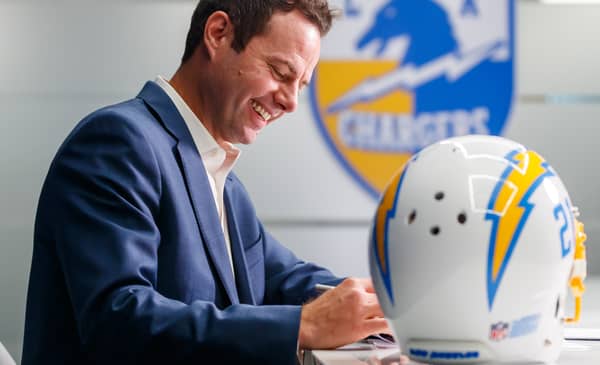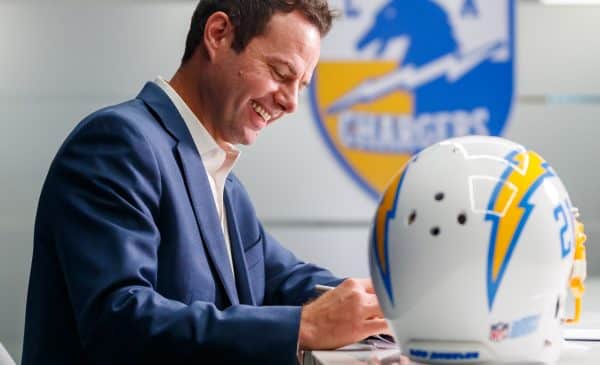
How The Chargers Became A Modern NFL Organization
Los Angeles Chargers fans breathed a sigh of relief when the team opted to not hire current New York Giants offensive coordinator Jason Garrett as their next head coach. Aside from coaching experience, there were no significant reasons for hiring Garrett; yet, Chargers fans were still nervous their least-favorite coaching candidate would be promoted to initiate the post-Lynn era. Hiring the human equivalent of warm vanilla ice cream is a move the organization committed to in 2013, and one could argue they made an even worse decision in 2017 by hiring a glorified running back coach. Garrett would have been the third in a line of coaches hired during the Tom Telesco regime to serve as what some feel is a puppet of the rich men upstairs. Chargers fans knew a letdown was possible, but would the organization really disappoint them once more just as they had with the hiring of Mike McCoy and Anthony Lynn despite so many young and talented options available?
After an unusual yet refreshing lengthy vetting of more than half a dozen available candidates, the Chargers gave the fans their answer: No. On January 17th, they hired former Rams defensive coordinator Brandon Staley.
This organization will never be the same.
The news of Staley’s hiring arrived within days of Philip Rivers’ retirement announcement. Fitting, as the departure of Rivers last year signaled what would ultimately be the beginning of a new kind of Chargers operation. Moving on from one of the most iconic football players in team history was always going to be both dangerous and difficult, but after Rivers’ decline in 2019, it became both inevitable and necessary. The team chose Oregon quarterback Justin Herbert with the sixth overall pick in the 2020 NFL Draft, a move criticized by many (myself included, though to a lesser extent) for being a safe pick headed towards a career of mediocre play.
That quarterback just broke the record for most touchdowns by any rookie quarterback despite not having a practice with the starting unit until Week 3. For his efforts, Herbert was also awarded the 2020 NFL Offensive Rookie of the Year Award. How did the Chargers see what many could not?
Reports suggest the team had their eyes on Herbert as early as 2019. They did their homework, but Telesco and company had to wait one more season as their future quarterback went back to school for one more year. So, they opted to draft the athletic and mobile Easton Stick in the fifth round instead. Two years prior, the Chargers traded for then-Buffalo Bills quarterback Cardale Jones to develop as a backup behind Rivers. They began piecing together the information they needed to successfully develop a quarterback they were never guaranteed to get. When they finally took Herbert they were ready; however, they were certainly not done yet. The Chargers subsequently hired Pep Hamilton to be Herbert’s quarterbacks’ coach, a move some would say was most responsible for his instant success.
Evident in the back foot bombs to Tyron Johnson or the scramble touchdown passes to Keenan Allen were the beginnings of the Chargers entering the modern era of quarterback play. Herbert to Allen will be electric for years to come, but the duo was not always guaranteed. While educated fans know very well the Chargers have regularly taken care of their own during the Telesco era, outsiders and misinformed fans often chastise the organization for being too cheap to pay their players. Surely they would watch Allen, Joey Bosa, and Austin Ekeler all leave to find success with other teams, right?
The final count: $239.6 million allocated towards three of its best young players, and 239.6 million reasons for the Chargers to never again have to hear about how their current regime fails to retain its talent.
These superstars and the players they line up with will only go as far as their head coach will take them; nowhere was this more obvious than this past year when Lynn and his staff failed to plan, adjust, or improve en route to a 7-9 season. The common denominator among all 16 games was scared football play and poor game management, a disease called losing transmitted from the head coach and infecting the rest of the coaching staff.
Retaining Lynn, Gus Bradley, Shane Steichen, and George Stewart for one more season of guaranteed failure and frustration would have been modus operandi for the Chargers. After all, there were legitimate excuses: An offseason halted by a pandemic, injuries, and of course the development of Herbert. The team had been 12-4 just a few years prior, and perhaps this same staff could get lucky in 2021.
Relying on luck leads to disappointment in the NFL, particularly when 53 other men and a coaching staff on the other sideline casts aside luck in favor of aggressiveness and smart football play. In Week 2, Lynn opted to punt on fourth down and give the ball back to the Kansas City Chiefs, who would march down the field and score the game-winning field goal. In the Divisional Round, that same Chiefs team went for it on fourth down and won the game. The Chargers are trying to figure out which offensive tackle to draft at 13. The Chiefs were one game away from needing to figure out how to make room for another Super Bowl trophy.
The Chargers have been a step behind the best teams in the NFL for years, but hiring Staley feels upon the first impression like a massive stride in the right direction. Where there was once a 4-3 defense with the lowest blitz rate in the NFL is a combination of elite talent showing multiple looks and pressuring the offense to break under its ferocity. Gone are the days of gut feelings and repetitive schemes, for in its place is an offense driven by analytics built around one of the most talented quarterbacks in the NFL. This Chargers team will beg for the opportunity to go for it on fourth down.
It all seems too good to be true, and when Michael Lombardi reported the Chargers were going to force their offensive coaching staff on their next head coach it felt as if fans were discovering they were duped the whole time.
What followed was entirely the opposite: Staley brought in a quarterbacks coach from the Shanahan system and an offensive coordinator who worked under Sean Payton and the New Orleans Saints. Those two offenses, combined with anything Staley absorbed from Sean McVay and the Rams, are as far away from the Lynn-Steichen duo as one could get.
So let this sink in: The Chargers’ offense will be an analytics-driven aggressive unit built around the reigning Offensive Rookie of the Year and based on the offensive combination of Shanahan, McVay, and Payton, and their multi-look defense will be captained by the man who just led the Rams to the No. 1 defense in the NFL despite not having a first-round draft pick in years.
It is abundantly clear they have taken the steps to become a modern organization. Welcome to the new era of Chargers football.

Ty Nowell captures a moment from Brandon Staley’s first day in the Chargers facility.
